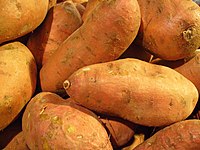
Photo from wikipedia
Sweet potato [Ipomoea batatas (L.) Lam] is grown as important cash and food crop worldwide and has been shown to exhibit allelopathic effects on other plants. However, its metabolome has… Click to show full abstract
Sweet potato [Ipomoea batatas (L.) Lam] is grown as important cash and food crop worldwide and has been shown to exhibit allelopathic effects on other plants. However, its metabolome has not been studied extensively, particularly with respect to the production of phytotoxic bioactive secondary products. In this study, the chemical composition of petroleum ether extract of sweet potato was characterized, and the morphological and physiological effects of some individual components against four invasive alien weeds Bidens pilosa L., Galinsoga parviflora Cav., Lolium multiflorum Lam., and Phalaris minor Retz. were determined. Twenty-one components were identified by GS-MS, constituting 96.08% of petroleum ether extract in sweet potato. The major components were palmitic acid (PA) (17.48%), ethyl linoleate (EL) (13.19%), linoleic acid (LA) (12.55%), ethyl palmitate (EP) (11.77%), ethyl linolenate (ELL) (8.29%) oleic acid (5.82%), ethyl stearate (4.19%), and 3-methylphenol acetate (3.19%). The five most abundant compounds exhibited strong inhibition activity against the four invasive weeds tested. The highest inhibition rates were seen for LA, followed by PA and EP, respectively. Catalase (CAT), malondialdehyde (MDA), and peroxidase (POD) content of L. multiflorum were increased by the three allelochemicals, i.e., LA, PA and EP, but superoxide dismutase (SOD), chlorophyll-a and chlorophyll-b levels declined. Overall, the combined impact of all five compounds could be quite effective in suppressing the invasive weeds of concern.
Journal Title: Frontiers in Plant Science
Year Published: 2022
Link to full text (if available)
Share on Social Media: Sign Up to like & get
recommendations!